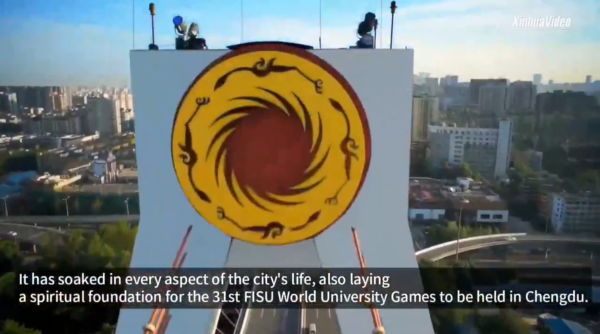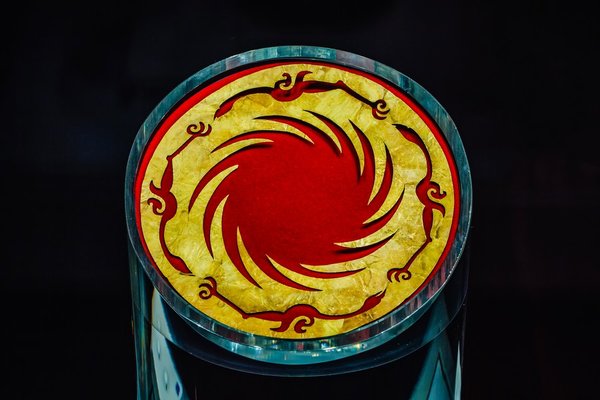China's Ancient Symbols Light up Upcoming World University Games
 |
| Click the photo and watch the video. |
* The image of a sun-and-immortal-birds gold ornament, unearthed in 2001 from the Jinsha Site, is omnipresent at the upcoming Chengdu Universiade.
* It not only represents the ancient Shu civilization but also resonates in the everyday life of Chengdu's 20 million inhabitants.
* Despite being a cultural relic from 3,000 years ago, the Sun and Immortal Birds Gold Ornament strikes a chord with the Olympic motto of "Faster, Higher, Stronger — Together."
CHENGDU, China, July 16 (Xinhua) — The torch relay of the 31st FISU World University Games is captivating observers on the campuses of Chengdu's colleges and universities, many of whom are charmed by the vibrant design of the torch.
Not just a blend of four gradient hues — vibrant red, sunny yellow, serene lake blue, and rich jade green — the Chengdu Universiade torch carries a unique design. It embodies the image of a sun-and-immortal-birds gold ornament, one of China's esteemed ancient treasures, unearthed in 2001 from the Jinsha Site — the epicenter of the bygone Shu Kingdom.
 |
| This photo shows the unearthed Sun and Immortal Birds Gold Ornament at the Jinsha Site in Chengdu of southwest China's Sichuan Province on Nov. 4, 2019. [Photo by Zhang Yan/Xinhua] |
With a history spanning approximately 3,000 years, the Jinsha Site was the ancient Shu Kingdom's capital and a cradle of ancient civilization nestled along the upper Yangtze River in China.
Symbol of Chinese Cultural Heritage
Currently housed in the exhibition hall of the Jinsha Site Museum is the Sun and Immortal Birds Gold Ornament, a crucial archaeological discovery from the Jinsha Site.
This circular gold ornament features two layers, with the inner circle consisting of 12 arc-shaped tooth-like appendages. These are encircled by four flying birds linked head to tail in a counterclockwise direction. During a clear day, the sunlight elegantly projects the dance of the Sun and Immortal Birds onto a large, curved wall.
 |
| The Sun and Immortal Birds Gold Ornament is seen on the dome of the Jinsha Site Museum in Chengdu of southwest China's Sichuan Province on March 10, 2022. [Photo by Zhang Yan/Xinhua] |
Zhu Zhangyi, the curator of the Jinsha Site Museum, said that the sun and sunbird have been revered symbols in the ancient Shu culture for thousands of years. "The heavenly bird circling the sun symbolizes the Chinese ancestors' aspirations to ascend to the sun and welcome the light," he expressed.
In 2005, this sun-and-birds gold foil was selected from among 1,600 artifacts as a symbol of Chinese Cultural Heritage. Further testament to its significance, on October 12, 2005, a Shu embroidery piece featuring the "Sun and Immortal Birds" design embarked on a five-day space journey aboard the Shenzhou VI spacecraft.
 |
| This aerial photo shows the Sun and Immortal Birds Gold Ornament in a flower field in Chengdu of southwest China's Sichuan Province. [Xinhua] |
The Sun and Immortal Birds not only represent the ancient Shu civilization but also resonate in the everyday life of Chengdu's 20 million inhabitants.
In the heart of Chengdu, Tianfu Square — an 88,000-square-meter transportation hub — hosts a commanding sculpture of the Immortal Birds at its core.
Moreover, the Chengdu Tianfu International Airport terminal building, a significant gateway in western China, is designed in the shape of an Immortal Bird, offering a memorable first impression of the city to travelers.
 |
| This aerial photo taken on Dec. 31, 2019 shows the Sun and Immortal Birds Gold Ornament on an observation deck of Longquanshan Forest Park in Chengdu of southwest China's Sichuan Province. [Photo by Hu Datian/Xinhua] |
Located 15 kilometers from Tianfu International Airport, the Longquan National Forest Park has become a popular destination for hikers, featuring a spiraling 360-degree observation deck, at the heart of which stands an Immortal Bird.
"The 'Sun and Immortal Birds' not only embody the city's cultural symbol but also reflect the outstanding traditional Chinese culture of pursuing light, self-renewal, and enterprise," said Wang Fang, deputy curator of the Jinsha Site Museum.
Omnipresent in Universiade Images
Despite being a cultural relic from 3,000 years ago, Zhu Zhangyi perceives a resonance between the Sun and Immortal Birds Gold Ornament and the Olympic motto of "Faster, Higher, Stronger — Together."
In the forthcoming Chengdu Universiade, the Sun and Immortal Birds, symbolizing elements of the ancient Shu culture, will also be showcased prominently.
 |
| This combined photo shows the stadium for the opening ceremony of the 31st FISU Summer World University Games and cauldron at Dong'an Lake Sports Park in Chengdu, southwest China's Sichuan Province (top, taken on April 19, 2023 by Shen Bohan) and the Sun and Immortal Birds Gold Ornament on the medal band of the Games (bottom, taken on June 14, 2023, by Xu Yangyuheng) [Xinhua] |
The Dong'an Lake Sports Park is a prime example. Its stadium, where the opening ceremony will unfurl on July 28, features an annular roof made of trapezoidal colored-glazed glass, mimicking the shape of the Sun and Immortal Birds Gold Ornament.
The Universiade medal design presents the Sun Bird in flight, signifying the event's slogan "Chengdu Makes Dreams Come True."
 |
| The Sun and Immortal Birds Gold Ornament is seen on a bridge in Chengdu of southwest China's Sichuan Province. [Xinhua] |
While sports dominate the Universiade's focus, culture imbues a significant role in shaping Chengdu's experience for both residents and visitors.
With the Universiade a mere 12 days away, the city's profound cultural heritage promises to contribute to an extraordinary global experience at the World University Games.
Xinhua reporters Dong Xiaohong, Tong Fang and Chen Di also contributed to the story.
(Source: Xinhua)
Please understand that womenofchina.cn,a non-profit, information-communication website, cannot reach every writer before using articles and images. For copyright issues, please contact us by emailing: website@womenofchina.cn. The articles published and opinions expressed on this website represent the opinions of writers and are not necessarily shared by womenofchina.cn.






.jpg)

 WeChat
WeChat Weibo
Weibo 京公网安备 11010102004314号
京公网安备 11010102004314号